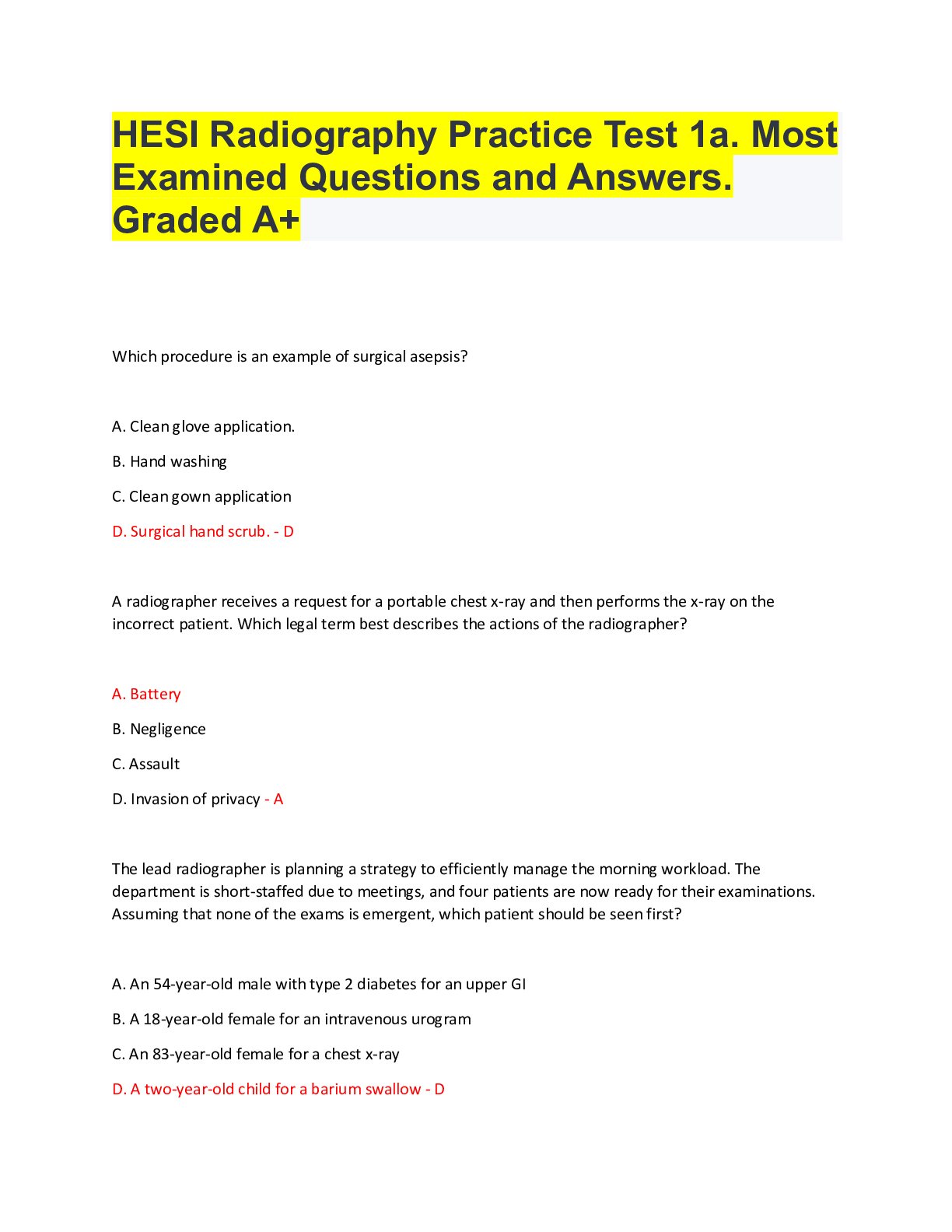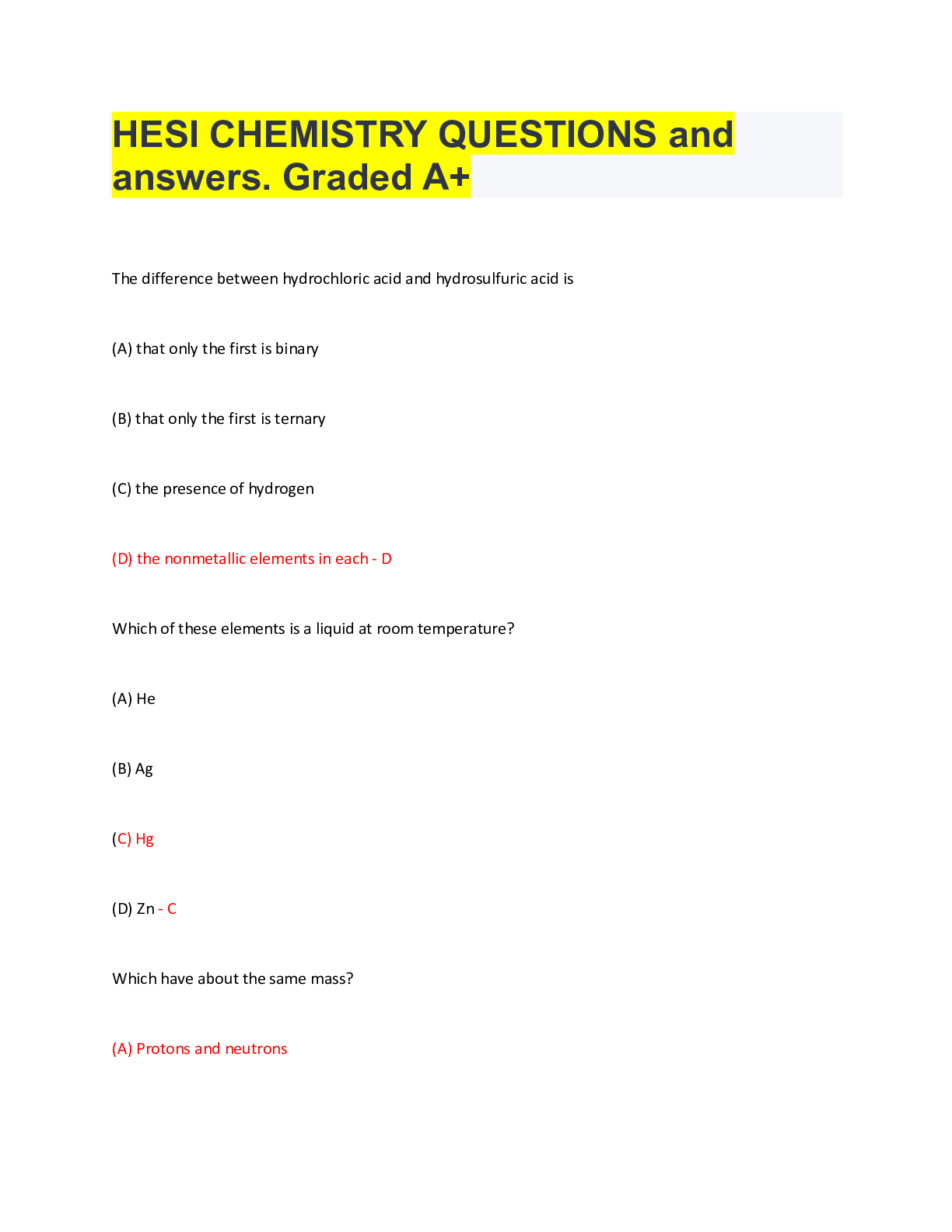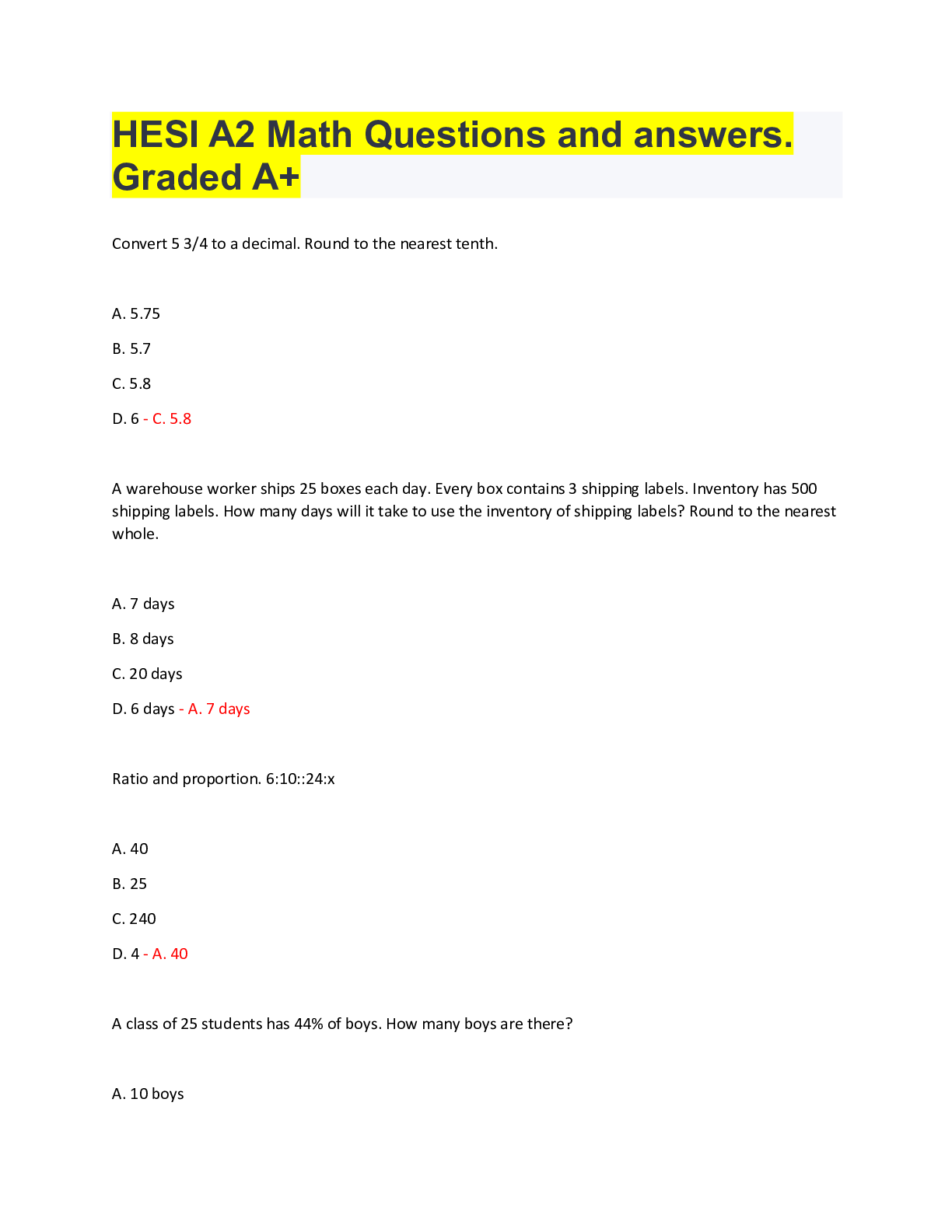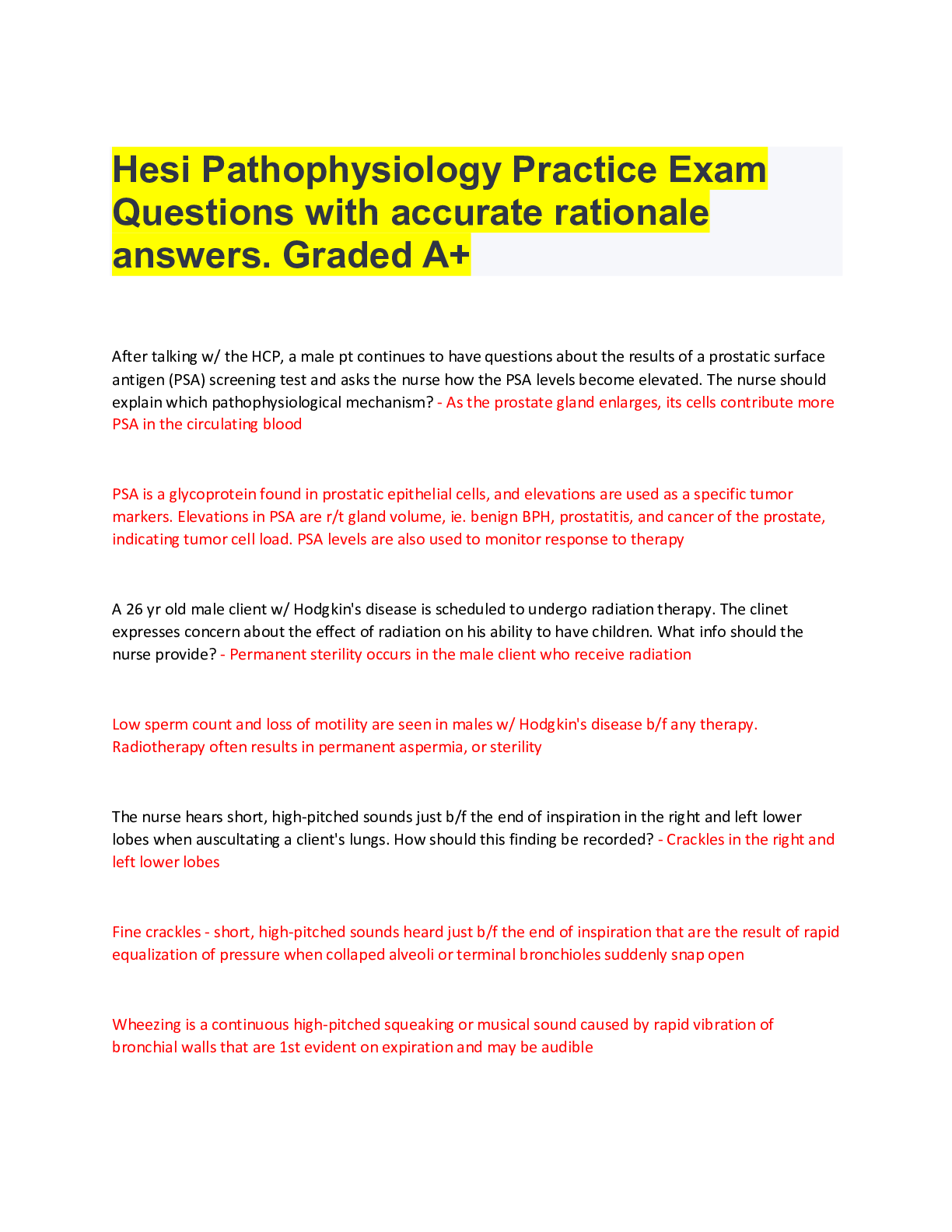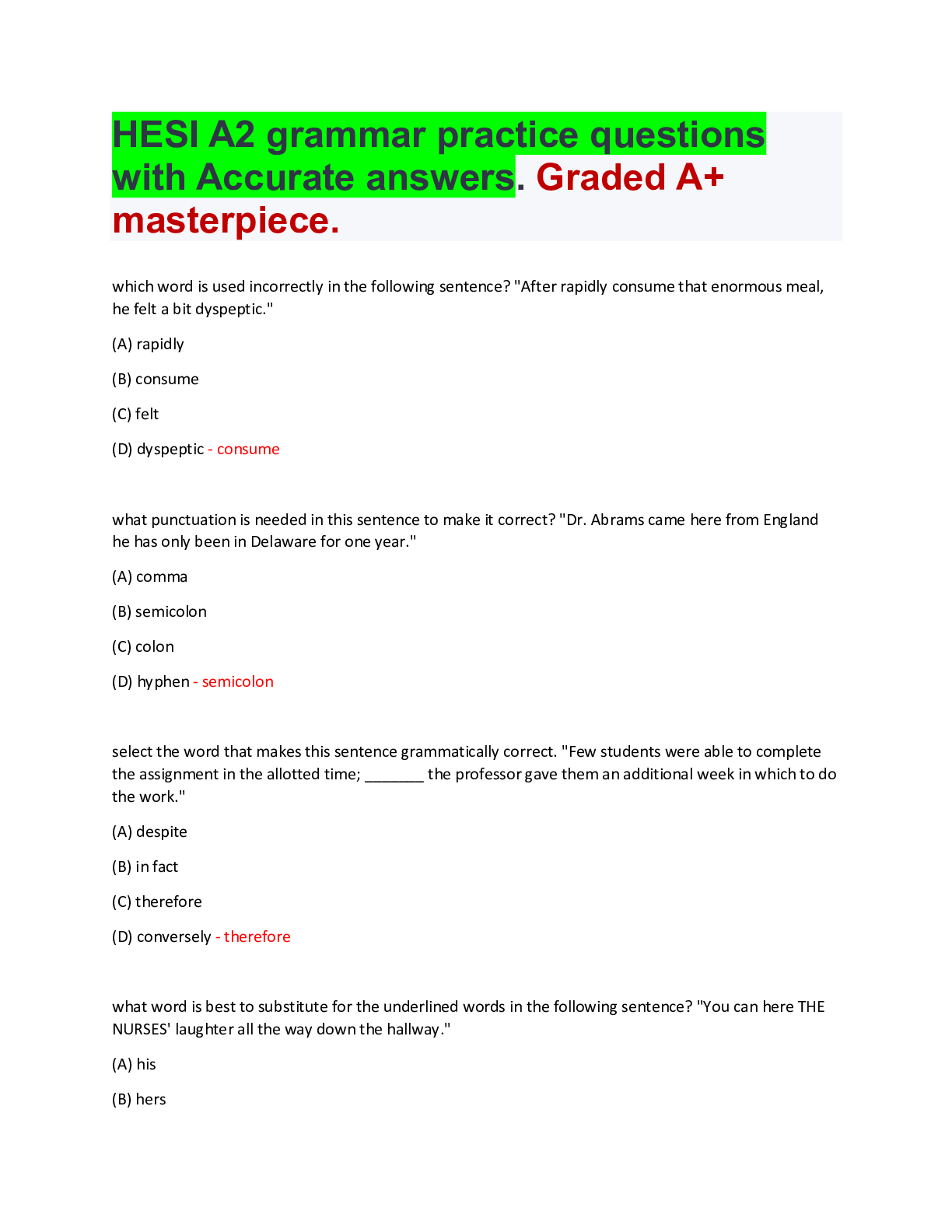Pathophysiology > HESI > HESI PATHO, Patho Hesi 2017 Practice Questions, Pathophysiology HESI, Questions and answers. Graded (All)
HESI PATHO, Patho Hesi 2017 Practice Questions, Pathophysiology HESI, Questions and answers. Graded A
Document Content and Description Below
HESI PATHO, Patho Hesi 2017 Practice Questions, Pathophysiology HESI, Questions and answers. Graded A Which rationale best supports an older client's risk of complications related to a dysrhythmi... a? - ✔✔An older client is intolerant of decreased cardiac output which may cause dizziness and falls In an older client, cardiac output is decreased and a loss of contractility and elasticity reduces systemic and cerebral blood flow, so dysrhythmias, such as bradycardia or tachycardia is poorly tolerated, and increases the client's risk for syncope, falls, transient ischemic attacks, and possibly dementia. - ✔✔ The nurse is assessing an older client and determines that the client's left upper eyelid droops, covering more of the iris than the right eyelid. Which description should the nurse use to document this finding? - ✔✔Ptosis of the left eyelid Ptosis is the term to describe an eyelid droop that covers a large portion of the iris astigmatism -- distortion of the lens of the eye, causing decreased visual acuity. nystagmus - ✔✔eye makes uncontrolled movements; oculomotor nerve or eyelid muscle disorder that is characterized by rapid, rhythmic movement of both eyes. exophthalmos - ✔✔protrusion of the eyeballs that occurs with hyperthyroidism The nurse is measuring blood pressure on all four extremities of a child with coarctation of the aorta. Which blood pressure finding should the nurse expect to obtain? - ✔✔Lower in the legs than the arms In coarctation of the aorta, a congenital constriction is found at the aorta near the ductus arteriosus region that lies past the left subclavian arteries, which perfuses the upper extremities. the child should have higher blood pressures in the upper extremities than in the legs. The nurse reviews the CBC findings of an adolescent with acute myelogenous leukemia. The hemoglobin is 13.8, hematocrit is 36.7 WBC is 8,200 and platelet count is 115,000., Based on these findings, what is the priority nursing dx for this client's plan of care? - ✔✔Risk for injury A client with AML is at risk for anemia, neurtropenia, and thrombocytopenia. These CBC findings indicate that the platelet count is low (Normal 250,000-400,000) which places this client at an increased risk for injury, usually manifested as bruising or bleeding. hemoglobin: 12-16 female 14-18 male hematocrit: 37-47 female 42-52 male WBC: 5,000-10,000 Platelets: 250,000-400,000 A nurse is planning to teach self-care measures to a female client about prevention of yeasts infections. Which instructions should the nurse provide? - ✔✔Avoid-tight fitting clothing do not use bubble-bath or bath salts A common genital tract infection in females is cadidiasis, which is an overgrowth of the normal vaginal flora of Candida albicans that thrives in an environment that is warm and moist and perpetuated by tight-fitting clothing, underwear, or pantyhose made of nonabsorbant materials. The client should wear clothing that is loose fitting and absorbent, such as cotton underwear, and avoid using bubble-bath or bath salts which further irritate sensitive genital tissue A client with asthma receives a rx for high blood pressure during a clinic visit. Which rx should the nurse anticipate the client to receive that is least likely to exacerbate asthma? - ✔✔Metoprolol tartrate (lopressor) The best antihypertensive agent for clients with asthma is lopressor a beta blocking agent which is also cardioselective and less likely to cause bronchocontriction. Which signs and symptoms are associated with arterial insufficiency? - ✔✔Pallor, intermittent claudication Pallor and intermittent claudication are signs related to stage II of PVD, which results in arterial insufficiency. Arterial insufficiency causes impaired perfusion resulting in hypoxic pain or intermittent claudication (pain in legs when working out bc not enough blood flow) Pedal edema, brown pigmentation are signs related to venous insufficiency Blanched skin, lower extremity ulcers are not specific to arterial disease Peripheral neuropathy may be related to complications of diabetes mellitus resulting in poor circulation A man who was recently diagnosed with huntington's disease asks the nurse if his adolescent son should be tested for the disease. What response is best for the nurse to provide? - ✔✔Testing is needed bc there is a 50% risk of passing the gene to each offspring Huntingdon's disease, a progressively incapacitating, fatal neuromuscular disease, is an autosomal dominant inherited disease that has a 50% risk of developing in each child of those who have the disorder. The risk of autosomal dominant inheritance should be explained and emphasized. A client with aortic valve stenosis develops HF. Which pathophysiological finding occurs in the myocardial cells as a result of the increased cardiac workload? - ✔✔Increase in size Hypertension and incompetent or stenotic heart valves cause an increase in the workload of the heart by increasing afterload which requires an increase in teh force of contraction to pump blood out of the heart. Myocardial hypertrophy results bc the cells increase in surface area or size by increasing the amount of contractile proteins, but the quantity of fibers remains constant. As myocardial hypertrophy progresses, the heart becomes ineffective as a pump bc the ventricular wall cannot develop enough tension to cause effective contraction, which causes myocardial irritability due to hypoxia. While the nurse obtains a male client's history, review of systems, and physical exam, the client tells the nurse that his breasts drain fluid secretions from the nipple. The nurse should seek further evaluation of which endocrine gland function? - ✔✔Hypothalamus and anterior pituitary Breast fluid and milk production are induced by the presence of prolactin secreted from the anterior pituitary gland, which is regulated by the hypothalamus' secretion of prolactin-inhibiting hormone in both men and women. Further evaluation of the hypothalamus and the anterior pituitary gland should provide additional information about secretions or lactation Several hours after surgical repair of an AAA, the client develops left flank pain. the nurse determines the client's urinary output is 20ml/hr for the past 2 hours. The nurse should conclude that these findings support which complication? - ✔✔Renal artery embolization Postop complications of surgical repiar of AAA are related to the location of resection, graft, or stent placement along the abdominal aorta. Emobolization of a fragment of thrombus or plaque from the aorta into a renal artery can compromise blood flow in one of the renal arteries, resulting in renal ischemia that precipitates unilateral flank pain. hypovolemia can cause acute renal failure which involves both kidneys and would cause bilateral flank pain A client with a fractured right radius reports severe, diffuse pain that has not responded to the rx analgesics. The pain is greater with passive movement of the limb than the active movement by the client. The nurse recognizes that the client is most likely exhibiting symptoms of which condition? - ✔✔acute compartment syndrome These signs are specific indications of acute compartment syndrome, and should be treated as an emergency situation. A client with a markedly distended bladder is dx with hydronephrosis and left hydroureter after an IV pyelogram. The nurse catheterizes the client and obtains a residual urine volume of 1650 ml. This finding supports with pathophysiological cause of client's urinary tract obstruction? - ✔✔Obstruction at the urinary bladder neck Hydroureter (dilation of the renal pelvis), vesicoureteral reflux (backward movement of urine from the lower to upper urinary tracts), and hydronephrosis (dilation or enlargement of the renal pelvis and calyces) result from post-renal obstruction which can consequently result in chronic pyelonephritis and renal atrophy. Ascending urinary reflux occurs when normal ureteral peristaltic pressure is met with an increase in urinary pressure occurring during bladder filling if the urinary bladder neck is obstructed. The nurse is teaching a client with maple syrup urine disease MSUD, an autosomal recessive disorder, about the inheritance pattern. Which information should the nurse provide? - ✔✔Both genes of a pair must be abnormal for the disorder to continue. MSUD is a type of Autosomal recessive inheritance disorder in which both genes of a pair must be abnormal for the disorder to be expressed. MSUD is not an x-linked dominant or recessive disorder or an autosomal dominant inheritance disorder. Which reaction should the nurse ID in a client who is responding to stimulation of the sympathetic nervous system? - ✔✔Increased heart rate Any stressor that is perceived as threatening to homeostasis acts to stimulate the sympathetic nervous system and manifests as a flight-or-fight response, which includes an increase in heart rate. Pupil constriction, bronchial constriction and decreased blood pressure are responses of the parasympathetic nervous system A 26-y/o male client with Hodgkin's disease is scheduled to undergo radiation therapy. The client expresses concern about the effect of radiation on his ability to have children. What information should the nurse provide? - ✔✔Permanent sterility occurs in male clients who receive radiation Low sperm count and loss of motility are seen in males with Hodgkin's disease before any therapy. Radiotherapy often results in permanent aspermia, or sterility. The nurse is assessing a client with a ruptured small bowel and determines that the client has a temperature of 102.8. Which assessment finding provides the earliest indication that the client is experiencing septic shock? - ✔✔Hyperpnea--increased depth of respirations The interrelated pathophysiologic changes associated with the hypermetabolic state of sepsis and septic shock produce a pathologic imbalance between cellular oxygen demand, supply, and consumption. Bilateral crackles, mucus production, and weak peripheral pulses are signs of advanced shock When observing a client for symptoms of a large bowel obstruction, the nurse should assess for which finding? - ✔✔Distention of the lower abdomen Among findings characteristic of a large bowel obstruction is the distention of the lower abdomen Nausea with profuse vomiting, fluid and electrolyte imbalance, and upper abdominal discomfort are signs of small bowel obstruction What histologic finding in an affected area of the body would suggest the presence of chronic inflammation? - ✔✔Increase in monocytes and macrophages A predominance of monocytes and macrophages in an inflamed area indicates the start of a chronic infection. Macrophages are responsible for "cleaning up" the healing wound through phagocytic and debridement actions, and monocytes assist in the healing of the wound after neutrophils have entered the area. Neutrophils arrive during the acute stage of inflammation rather than the later, chronic stage The nurse is caring for a client with syndrome of inappropriate ADH, which is manifested by which symptoms? - ✔✔loss of thirst, weight gain SIADH=too much ADH--water retention--not peeing--hyponatremia --increase in fluid volume --increased sodium loss in urine SIADH occurs when the posterior pituitary gland releases too much ADH, causing water retention, a urine output of less than 20ml/hr, and dilutional hyponatriemia. Other indications of SIADH are loss of thirst, weight gain, irritability, muscle weakness, and decreased LOC. SIADH leads to hyponatremia A mother is crying as she holds and rock her child with tetanus who is having muscular spasms and crying. After administering diazepam (Valium) to the child, what action should the nurse implement? - ✔✔Lay the child down and ask the mother to stay near the child in the crib. Controlling environmental stimulation such as noise, light, or tactile stimuli helps reduce CNS irritability related to acute tentanus. The mother should be instructed to minimize handling of the child during episodes of muscle spasticity and to stay calmly near the child. The mother's presence with the child provides security and support. A middle-aged male client asks the nurse what findings from his digital rectal exam prompted the healthcare provider to rx a repeat digital serum prostatic surface antigen level. What information should the nurse provide? - ✔✔Stony, irregular nodules palpated on the prostate should be further evaluated. PSA levels are rx to screen for prostatic cancer which is often detected by DRE and manifested as small, hard, or stony, irregularly shaped nodules on the surface of the prostate. A client is brought to the ER after snow-skiing accident. Which intervention is most important for the nurse to implement? - ✔✔Review the EKG tracing. Airway, breathing, and circulation are priorities in client assessment and treatment. Continuous cardiac monitoring is indicated bc hypothermic clients have an increased risk for dysrhythmias. Which client is at highest risk for chronic kidney disease secondary to diabetes mellitus? - ✔✔Type I DM and retinopathy and mild vision loss Diabetic retinopathy and nephropathy are related to prolonged hyperglycemia and hypertension which damage the microvasculature of the eyes and kidneys, so a client with Type I DM and retinopathy is most likely to develop nephropathy and CKD. A1c = less than 7% ideal After talking with the HCP, a male client continues to have questions about the results of prostatic surface antigen screening test and asks the nurse how the PSA levels become elevated. the nurse should explain which pathophysiological mechanism? - ✔✔As prostate gland enlarges, its cells contribute more PSA in the circulating blood. PSA is a glycoprotein found in prostatic epithelial cells, and elevations are used as specific tumor markers. Elevations in PSA are related to gland volume, i.e., benign prostatic hypertrophy, prostatitis, and cancer of the prostate, indicating (tumor) cell load. PSA levels are also used to monitor response to therapy a client is admitted to the ED with a tension pneumothorax. Which assessment should the nurse expect to ID? - ✔✔a deviation of the trachea toward the side opposite the pneumothorax Tension pneumothorax is caused by rapid accumulation of air in the pleural space, causing severely high intrapleural pressure. This results in the collapse of the lung, and the mediastinum shifts toward the unaffected side, which is subsequently compressed. Which pathophysiological response supports a client's vomiting experience? - ✔✔Spasmodic reflex of respiratory and gastric movements results from stimulation of chemoreceptor trigger zone Vomiting is a reflex of spasmodic respiratory movements against the glottis causing the forceful expansion of the contents of the stomach through the mouth. Stimulation of the emetic center results from afferent vagal and sympathetic nerve pathways that activate the chemoreceptor trigger zone. Physical examination of a comatose client reveals decorticate posturing. Which statement is accurate regarding this client's status based upon this finding? - ✔✔Severe dysfunction of the cerebral cortex has occurred. Decorticate posturing (adduction of arms at shoulders, flexion of arms on chest with wrists flexed and hands fisted and extension and adduction of extremities) is seen with severe dysfunction of the cerebral cortex. decerebrate posturing (rigid extension and pronation of arms and legs)= dysfunction of midbrain The parents of a child with hemophilia A ask the nurse about their probability of having another child with hemophilia A. Which information is the basis for the nurse's response? - ✔✔Sons of female carriers have a 50% chance of inheriting hemophilia Hemophilia is an X-linked recessive disorder Hemophilia is an inherited disease that manifests in male children whose mother is a carrier. X-linked recessive; With each pregnancy there is a 50% chance that a male child will inherit the defective gene and manifest hemophilia A. Men with hemophilia cannot give it to a son Boys XY Girls XX Girls have 50% chance of being a carrier. Rare kind of hemophilia called von Willebrand's disease is autosomal dominant A female client tells the nurse that she does not know which day of the month is best to do breast-self exams. Which instructions should the nurse provide. - ✔✔5-7 days after menses cease Due to the effect of the cyclic ovarian changes on the breast, the best time for BSE is 5-7 days after menstruation stops bc physiologic alterations in breast size and activity reach their minimal level after menses A client's family asks why their mother with HF needs a pulmonary artery (PA) catheter now that she is in the ICU. What information should the nurse include in the explanation to the family? - ✔✔A pulmonary artery catheter measures central pressures for monitoring fluid replacement Pulmonary artery catheters are used to measure central pressures and fluid balance. Even though all client's in the ICU require close monitoring, they do not all need PA catheter. A client who is receiving a whole blood transfusion develops chills, fever, and a headache 30 minutes after the transfusion is started. The nurse should recognize these symptoms as characteristic of what rxn? - ✔✔A febrile transfusion rxn -- associated with fever but not hemolysis --less severe Symptoms of a febrile rxn include sudden chills, fever, headache, flushing, and muscle pain. Allergic rxn: response of histamine release which is characterized by flushing, itching, and urticaria(hives) An anaphylactic rxn exhibits an exaggerated allergic response that progresses to shock and possible cardiac arrest Acute hemolytic rxn: presents with fever and chills, but is hallmarked by the onset of low back pain, tachycardia, tachypnea, vascular collapse, hemoglobinuria, dark urine, acute renal failure, shock, cardiac arrest and even death The nurse is preparing to administer atropine, an anticholinergic, to a client who is scheduled for a cholecystectomy. The client asks the nurse to explain the reason for the rx medication. What response is best for the nurse to provide? - ✔✔Decrease the risk for bradycardia during surgery Atropine may be rx preoperatively to increase the automaticity of the sinoatrial node and prevent a dangerous reduction in heart rate during surgical anesthesia muscular dystrophy is characterized by which pathophysiological condition? - ✔✔Skeletal muscle degeneration Skeletal muscle degeneration is a classic symptom if MD. Tremors and trembling of hands, particularly when stressed, are symptoms of Parkinson's. A nurse is caring for a client who had an excision of a malignant pituitary tumor. Which findings should the nurse document that indicate the client is developing syndrome of inappropriate ADH? - ✔✔Weight gain and low serum sodium SIADH most frequently occurs when cancer cells manufacture and release ADH, which is manifested by water retention causing weight gain and hyponatriemia. Other manifestation include oliguria, weakness, anorexia, nausea, vomiting, personality changes, seizures, decrease in reflexes, and coma The nurse is analyzing the waveforms of a client's EKG. What finding indicates a disturbance in electrical conduction in the ventricles? - ✔✔QRS interval of 0.14 second The normal duration of QRS is 0.04 to 0.12 second, so a prolonged QRS indicates an electrical anomaly in the ventricles. The T wave is normally 0.16 seconds. The PR interval range is 0.12 to 0.2 second. QT interval should be 0.31 to 0.38 second QRS->PR->T->QT The nurse is caring for a client with syndrome of inappropriate ADH. this condition is most often related to which predisposing condition? - ✔✔small cell lung cancer being the most common cancer that increases ADH, which causes dilutional hyponatremia and fluid retention ; CNS trauma or disease are most likely causes Which clinical finding should the nurse ID in a client who is admitted with cardiac cirrhosis? - ✔✔Peripheral edema 4 types of cirrhosis include alcoholic, post-necrotic, biliary, and cardiac cirrhosis, which is associated with severe right sided HF, so peripheral edema is the most consistent with RHF Which condition is associated with an oversecretion of renin? - ✔✔Hypertension Renin is an enzyme synthesized and secreted by the juxtaglomerular cells of the kidney in response to renal artery blood volume and pressure changes. Low renal perfusion stimulates the release of renin, which is converted by angiotensinogen into angiotensin I, which causes the secretion of aldosterone, resulting in renal reabsorption of sodium, water, and subsequently increases blood pressure. A deficiency of intrinsic factor should alert the nurse to assess a client's history for which condition? - ✔✔Pernicious anemia PA is a type of anemia due to failure of absorption of vitamin B12. The most common cause is lack of intrinsic factor, a glucoprotein produced by the parietal cell of the gastric lining. The severity of diabetic retinopathy is directly related to which condition? - ✔✔Poor blood glucose control Worsens diabetic retinopathy, where as tight glucose control can lessen its severity The nurse is planning care for a client who has a right hemispheric stroke. Which nursing dx should the nurse include in the plan of care? - ✔✔Risk for injury related to denial of deficits and impulsiveness With right-brain damage, a client experience difficulty in judgement and spatial perception and is more likely to be impulsive and move quickly, which placing the client at risk for falls. Although clients with right and left hemisphere damage may experience impaired physical mobility, the client with right brain damage will manifest physical impairments on the contralateral side of the body, not the same side. The client with a left-brain injury may manifest right-sided hemiplegia with speech or language deficits A client with left brain damage is more likely to be aware of the deficits and experience grief related to physical impairment and depression. A client reports unprotected sexual intercourse one week ago and is worried about HIV exposure. An initial HIV antibody screen (ELISA) is obtained. The nurse teaches the client that seroconversion to HIV positive relies on antibody production by B lymphocytes after exposure to the virus. When should the nurse recommend the client return for repeat blood testing? - ✔✔6-12 weeks Although the HIV antigen is detectable appox. 2 weeks after exposure, seroconversion to HIV + may take up to 6-12 weeks after exposure, so the client should return to repeat the serum screen for the presence of HIV antibodies during that time frame. The nurse is assessing a postmenopausal woman who is complaining of urinary urgency and frequency and stress incontinence. She also reports difficulty in emptying her bladder. These complaints are most likely due to which condition? - ✔✔Cystocele This constellation of signs in a postmenopausal woman are characteristic of a cystocele (prolapsed bladder) A male client who has never smoked but has had COPD for the past 5 tears is now being assessed for cancer of the lung. The nurse knows that he is most likely to develop which kind of lung cancer? - ✔✔Adenocarinoma the only lung cancer not related to cigarette smoking. It has been found to be directly related to lung scarring and fibrosis from pre-existing pulmonary disease such as TB or COPD. Oat-cell carcinoma and squamous cell carcinoma are caused by smoking malignant melanoma is skin cancer The nurse hears short, high-pitched sounds just before the end of inspiration in the right and left lower lobes when auscultating a client's lungs. How should this finding be recorded? - ✔✔Crackles in the right and left lower lobes Fine crackles are short, high-pitched sounds heard just before the end of inspiration that are the result of rapid equalization of pressure when collapsed alveoli or terminal bronchioles suddenly snap open. Wheezing: continous high-pitched squeaking or musical sound caused by rapid vibration of bronchial walls that are first evident on expiration and may be audible Pleural friction rub: creaking or grating sound from roughened, inflammed surfaces of the pleura rubbing together heard during inspiration, expiration, and with no change during coughing. What is the underlying pathophysiologic process between free radicals and destruction of a cell membrane? - ✔✔Enzyme release from lysosomes oxidative damage to cells is thought to be a causative factor in disease and aging. If free radicals bind to polyunsaturated fatty acids found in the lysosome membrane, the lysosome, nicknamed "suicide bags", leaks its protein catalytic enzymes intracellularly and the cell is destroyed. The nurse is assessing the laboratory results for a client who is admitted with renal failure and osteodystrophy. Which findings are consistent with this client's clinical picture? - ✔✔Serum K of 5.5 and total calcium of 6 In renal failure, normal serum electrolyte balance is altered bc the kidneys fail to activiate vitamin D, calcium absorption is impaired, and serum calcium decreases, which stimulates the release of PTH causing resorption of calcium and phosphate from the bone. A decreased tubular excretion and a decreased GFR results in HYPOcalcemia, HYPERphosphatemia, HYPERkalemia. high BUN is not renal; dehydration or liver pathology Which healthcare practice is most important for the nurse to teach a postmenopausal client? - ✔✔Consume adequate foods rich in calcium Bone density loss associated with osteoporosis increases at more rapid rate when estrogen levels begin to fall, so the most important healthcare practice during menopause is ensuring an adequate calcium intake to help maintain bone density and prevent osteoporosis. What information should the nurse include in a teaching plan about the onset of menopause? - ✔✔Smoking, Oophorectomy with hysterectomy, genetic influence, early menarche, chemotherapy influence Menopausal symptoms are related to the cessation of ovarian function. Factors influencing the onset of menopause include smoking, genetic influences, early menarche, surgical removal, and exposure to chemotherapy agents and radiation. The nurse hears short, high-pitched sounds just before the end of inspiration in the right and left lower lobes when auscultating a client's lungs. How should this finding be recorded? A. Inspiratory wheezes in both lungs B. Crackles in the right and left lower lobes C. Abdominal lung sounds in the bases of both lungs D. Pleural friction rub in the right and left lower lobes - ✔✔B Fine crackles are short, high pitched sounds heard just before the end of inspiration that are the result of rapid equalization of pressure when collapsed alveoli or terminal bronchioles suddenly snap open. Wheezing (A) is a continuous high pitched squeaking or musical sound caused by rapid vibration of bronchial walls that are first evident on expiration and may be audible. Although (C) describes an adventitious lung sound, the documentation is vague. (D) is a creaking or grating sound from roughened, inflamed surfaces of the pleura rubbing together heard during inspiration, expiration, and with no change during coughing. The nurse is assessing an older client and determines that the client's left upper eyelid droops, covering more of the iris than the right eyelid. Which description should the nurse use to document this finding? A. Ptosis on the left eyelid B. A nystagmus on the left C. Astigmatism on the right D. Exophthalmos on the right - ✔✔A Ptosis is the term used to describe an eyelid droop that covers a large portion of the iris, which may result from oculomotor nerve or eyelid muscle disorder. (B) is characterized by rapid, rhythmic movement of both eyes. (C) is a distortion of the lens of the eye, causing decreased visual acuity. (D) is a term used to describe a protrusion of the eyeballs that occurs with hyperthyroidism A client's family asks why their mother with heart failure needs a pulmonary artery catheter now that she is in the ICU. What information should the nurse include in the explanation to the family? A. A central monitoring system reduces the risk of complications undetected by observation B. A pulmonary artery catheter measures central pressure for monitoring fluid replacement C. Pulmonary artery catheters allow for early detection of lung problems D. The healthcare provider should explain the many reasons for its use. - ✔✔B Pulmonary artery catheters are used to measure central pressures and fluid balance. Even though all clients in the ICU require close monitoring, they do not all need a PA catheter (A). PA lines do not detect pulmonary problems (C). (D) avoids the family's question. Several hours after surgical repair of an abdominal aortic aneurysm, the client develops left flank pain. The nurse determines the client's urinary output is 20 mL/hr for the past 2 hours. The nurse should conclude that these findings support which complication? A. Infection B. Hypovolemia C. Intestinal ischemia D. Renal artery embolization - ✔✔D Postoperative complications of surgical repair of AAA are related to the location of resection, graft, or stent placement along the abdominal aorta. Embolization of a fragment of thrombus or plaque from the aorta into a renal artery can compromise blood flow in one of the renal arteries, resulting in renal ischemia that precipitates unilateral flank pain. Intraoperative blood loss or rupture of the aorta anastomosis can cause acute renal failure related to hypovolemia (B), which involves both kidneys and causing bilateral flank pain. (A) and (C) are not associated with these symptoms The nurse is assessing a postmenopausal woman who is complaining of urinary urgency and frequency and stress incontinence. She also reports difficulty emptying her bladder. These complaints are most likely due to which condition? A. Cystocele B. Bladder infection C. Pyelonephritis D. Irritable bladder - ✔✔A This constellation of signs in a postmenopausal woman are characteristic of cystocele. These symptoms are not characteristic of (B), (C), or (D) A male client who has never smoked by has had COPD is now being assessed for cancer of the lung. The nurse knows that he is most likely to develop which type of lung cancer? A. Adenocarcinoma B. Oat-cell carcinoma C. Malignant melanoma D. Squamous cell carcinoma - ✔✔A Adenocarcinoma is the only lung cancer not related to cigarette smoking. It has been found to be directly related to lung scarring and fibrosis from preexisting pulmonary disease such as TB or COPD. Both (B) and (D) are malignant lung cancers related to cigarette smoking. (C) is a skin cancer and is related to sunlight, not to lung problems Muscular Dystrophy is characterized by which pathophysiological condition? A. Stressed induced tremor and trembling B. Cardiac damage C. Seizure activity D. Skeletal muscle degeneration - ✔✔D Skeletal muscle degeneration is a classic symptom of muscular dystrophy. Tremors and trembling (A) of hands, particularly when stressed are symptoms of Parkinson's. Cardiac damage (B) and seizures (C) are not exclusive to muscular dystrophy The nurse is preparing to administer atropine, an anticholinergic, to a client who is scheduled for a cholecystectomy. The client asks the nurse to explain the reason for the prescribed medication. What is the best response for the nurse to provide? A. Provide a more rapid induction of anesthesia B. Decrease the risk of bradycardia during surgery C. Induce relaxation before induction of anesthesia D. Minimize the amount of analgesia needed postoperatively - ✔✔B Atropine may be prescribed to increase the automaticity of the SA node and prevent a dangerous reduction in HR during surgical anesthesia. (A), (C), and (D) do not address the therapeutic action of atropine use perioperatively What information should the nurse include in a teaching plan about the onset [Show More]
Last updated: 1 year ago
Preview 1 out of 71 pages
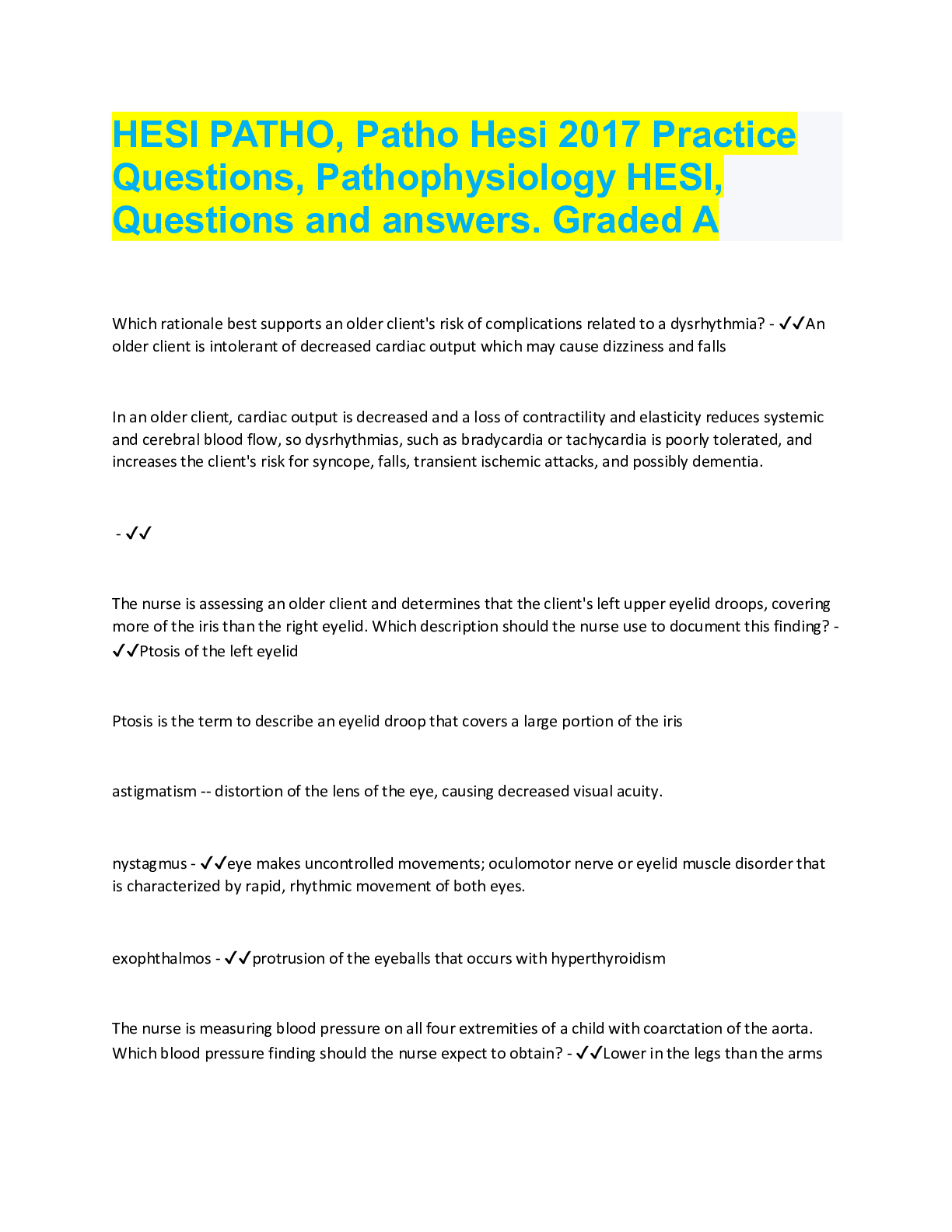
Reviews( 0 )
Document information
Connected school, study & course
About the document
Uploaded On
Oct 04, 2022
Number of pages
71
Written in
Additional information
This document has been written for:
Uploaded
Oct 04, 2022
Downloads
0
Views
69

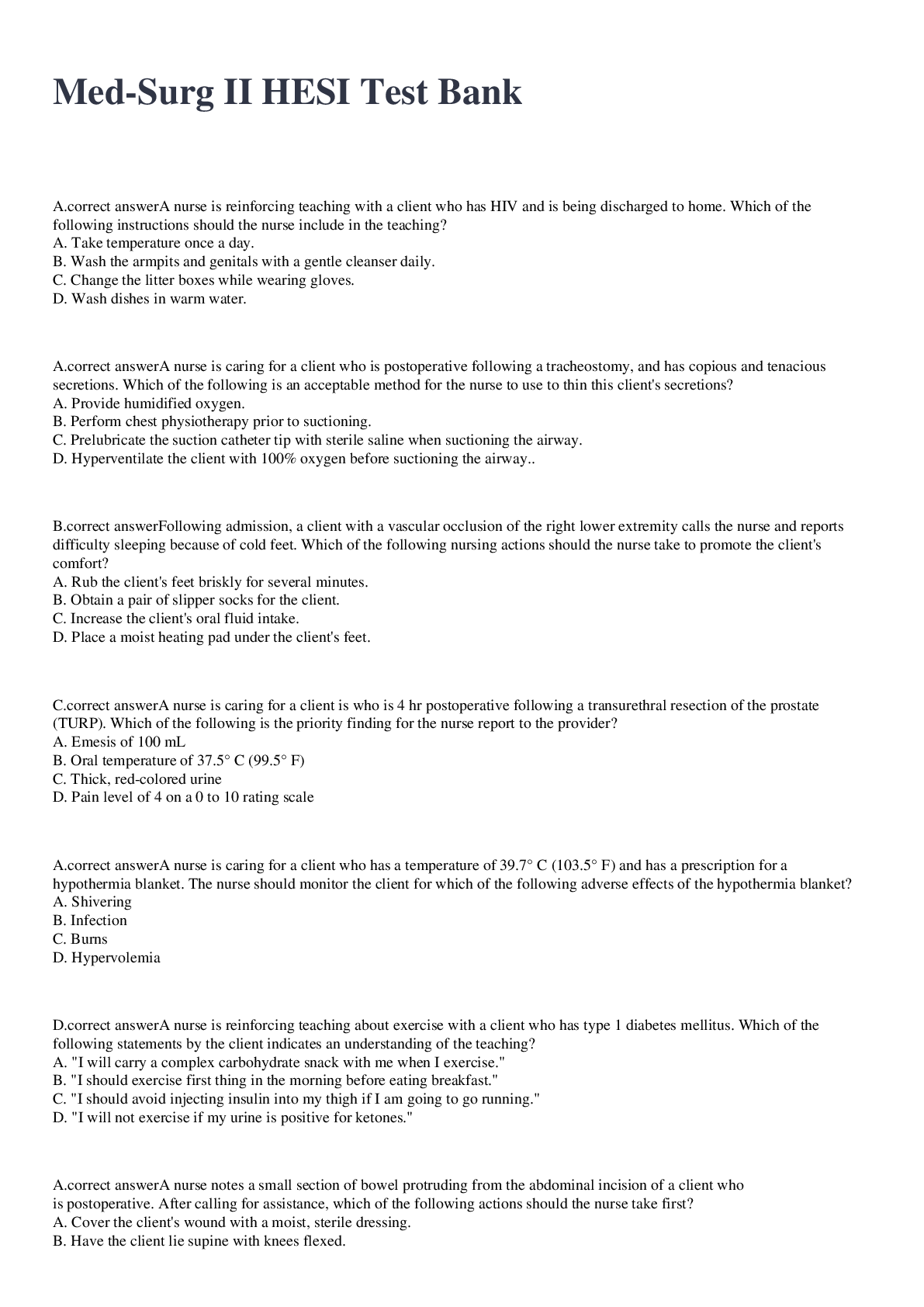

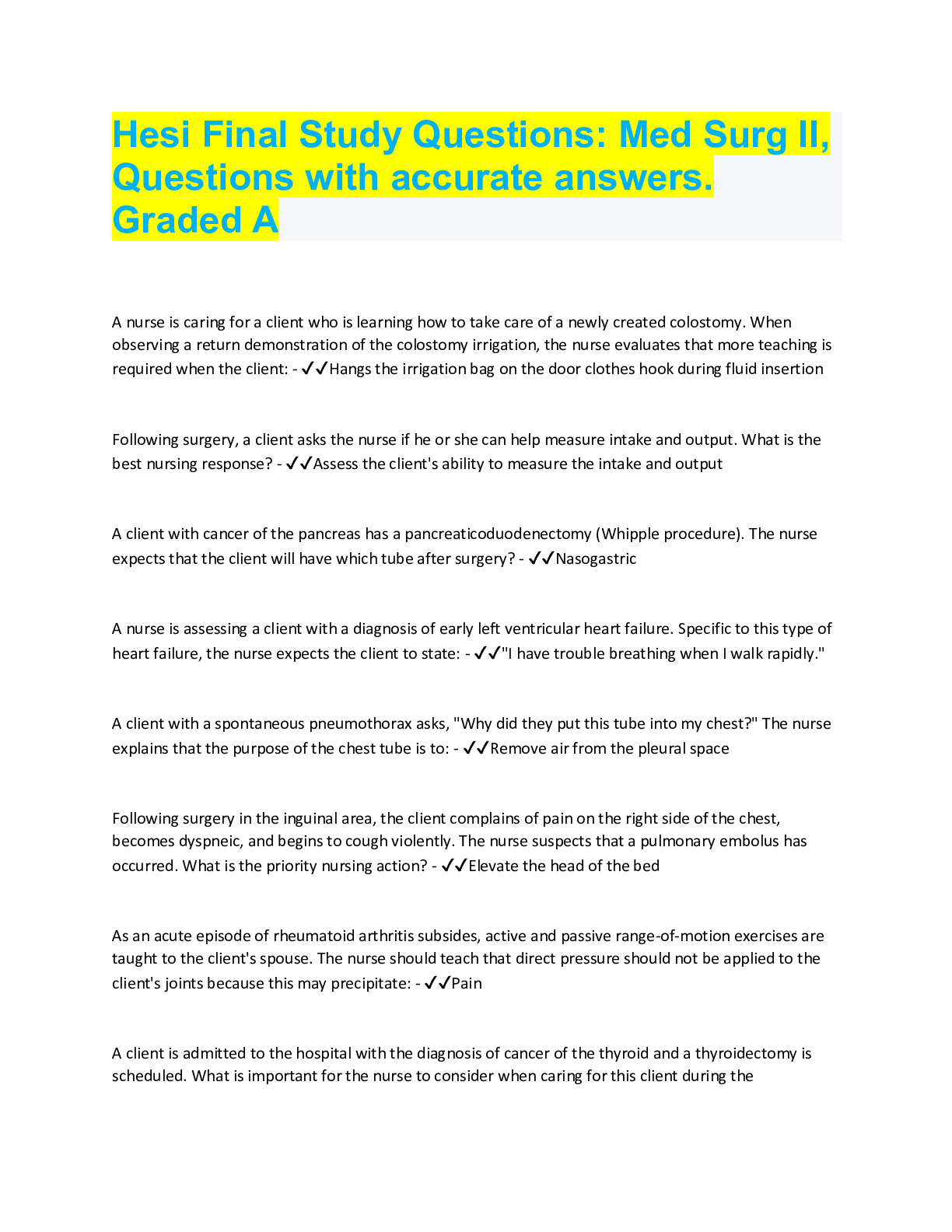


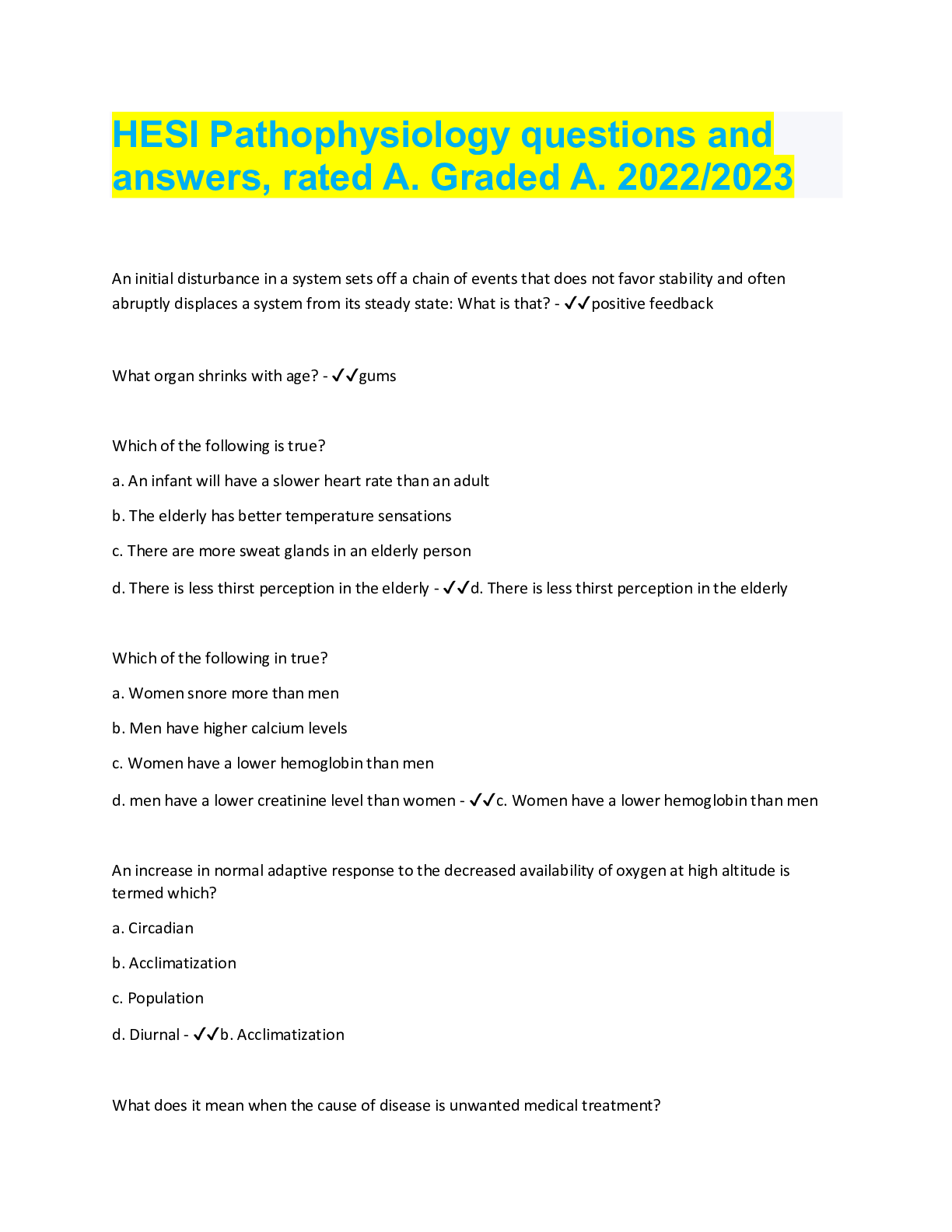
_merged.png)
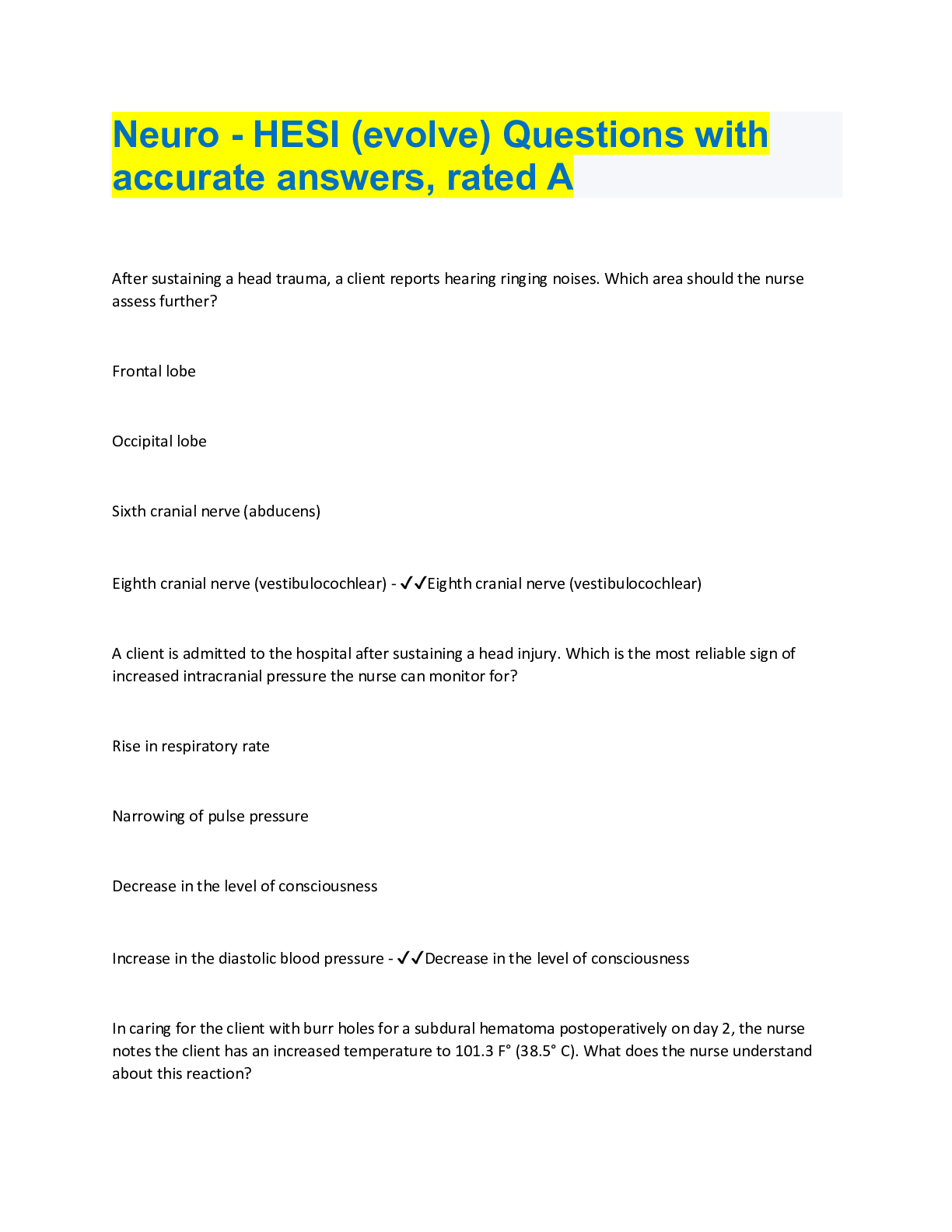
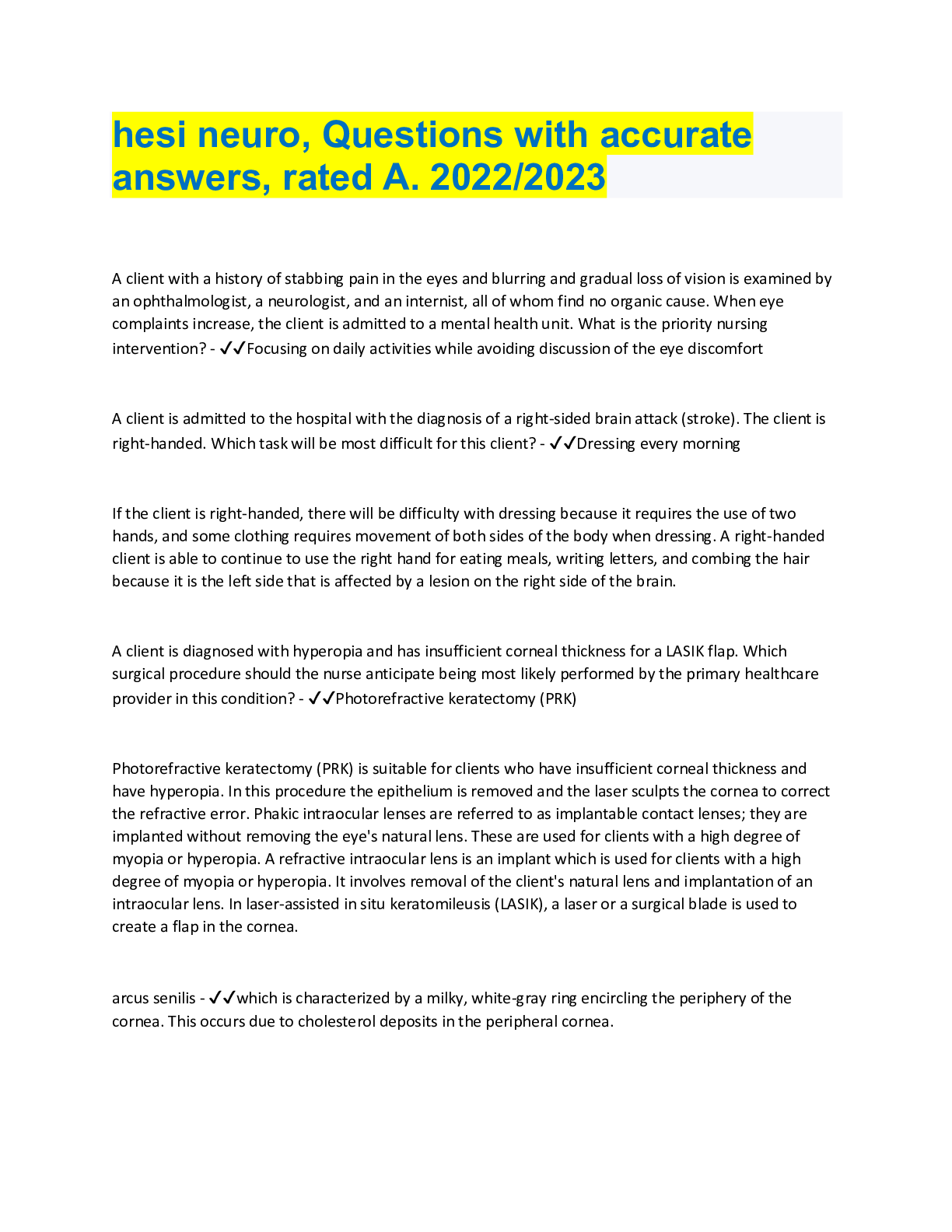

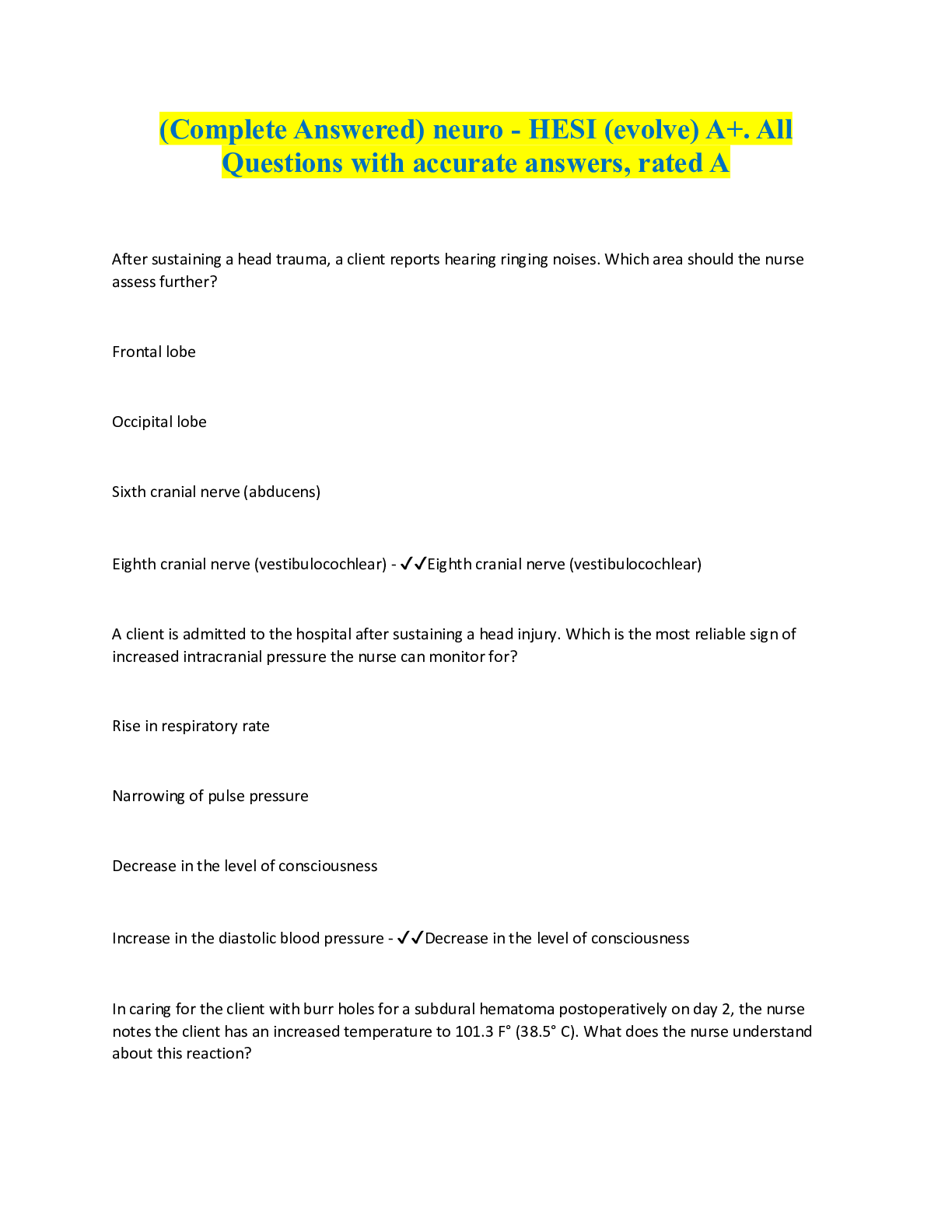
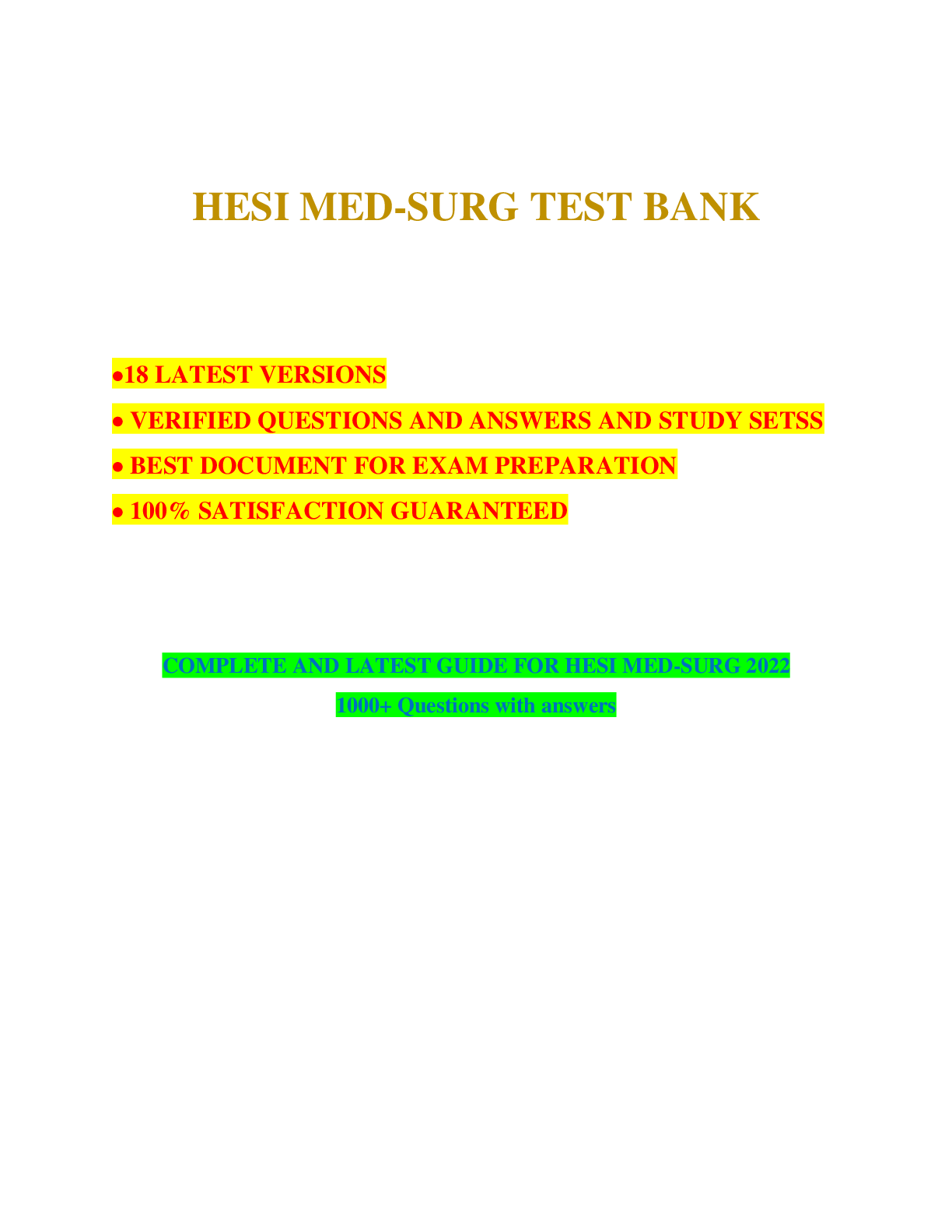


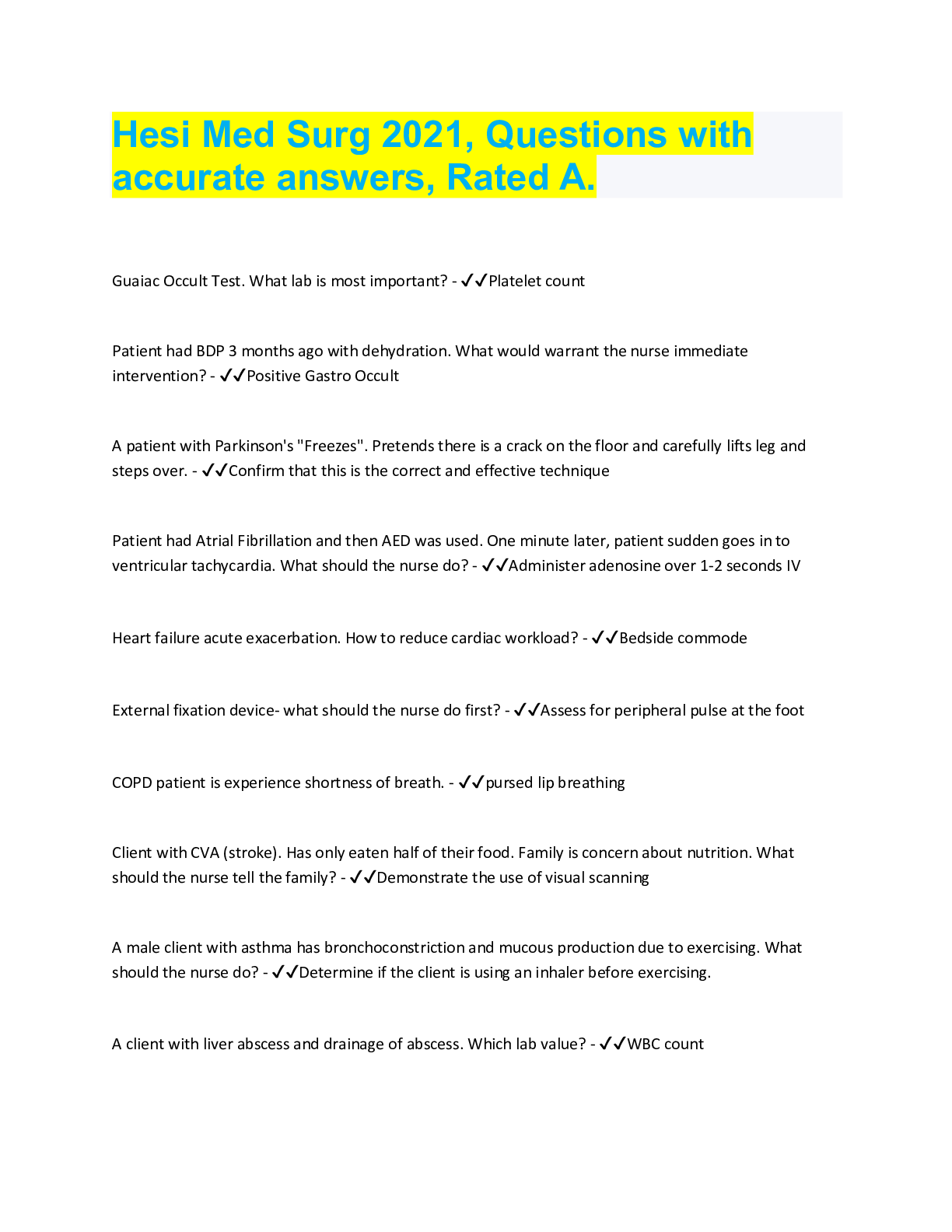
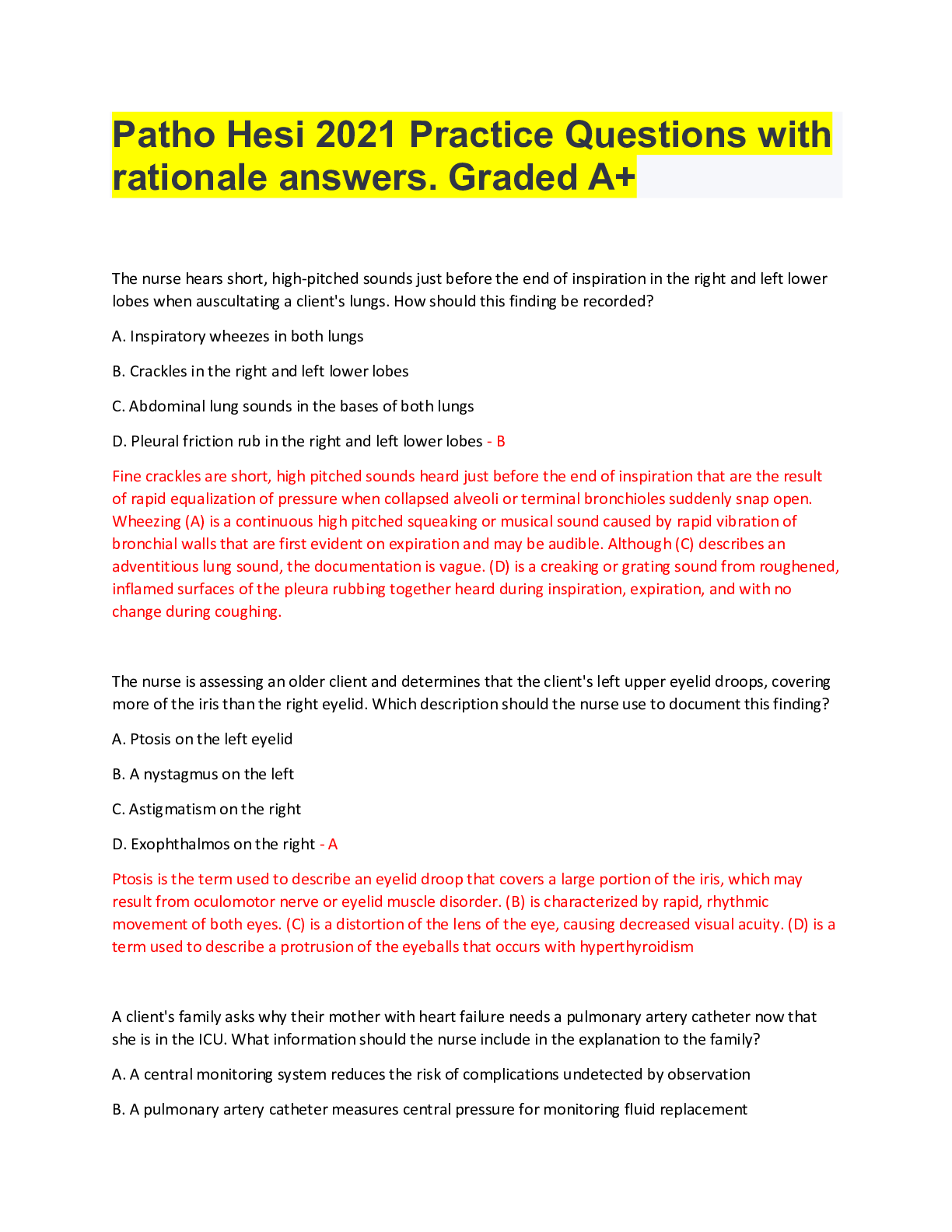

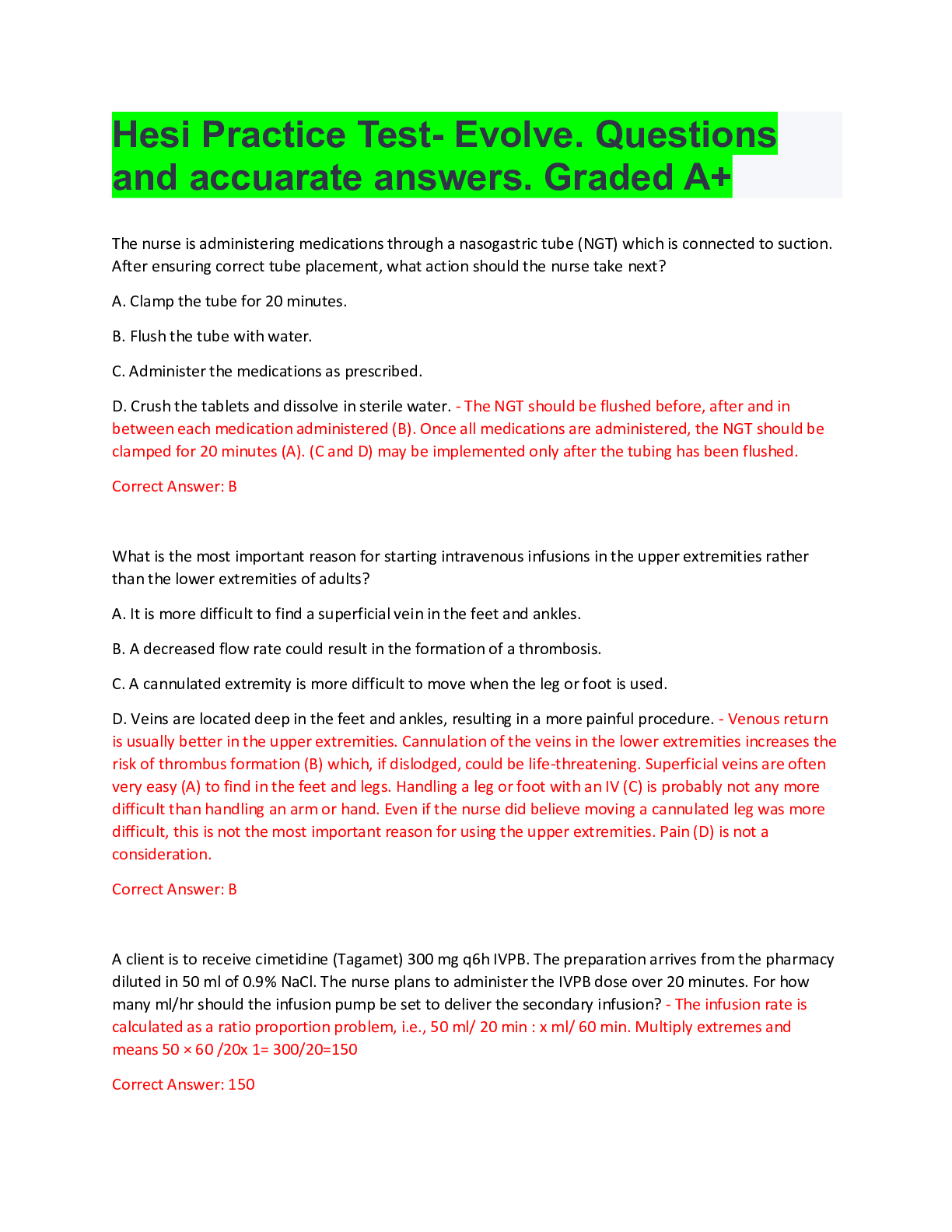
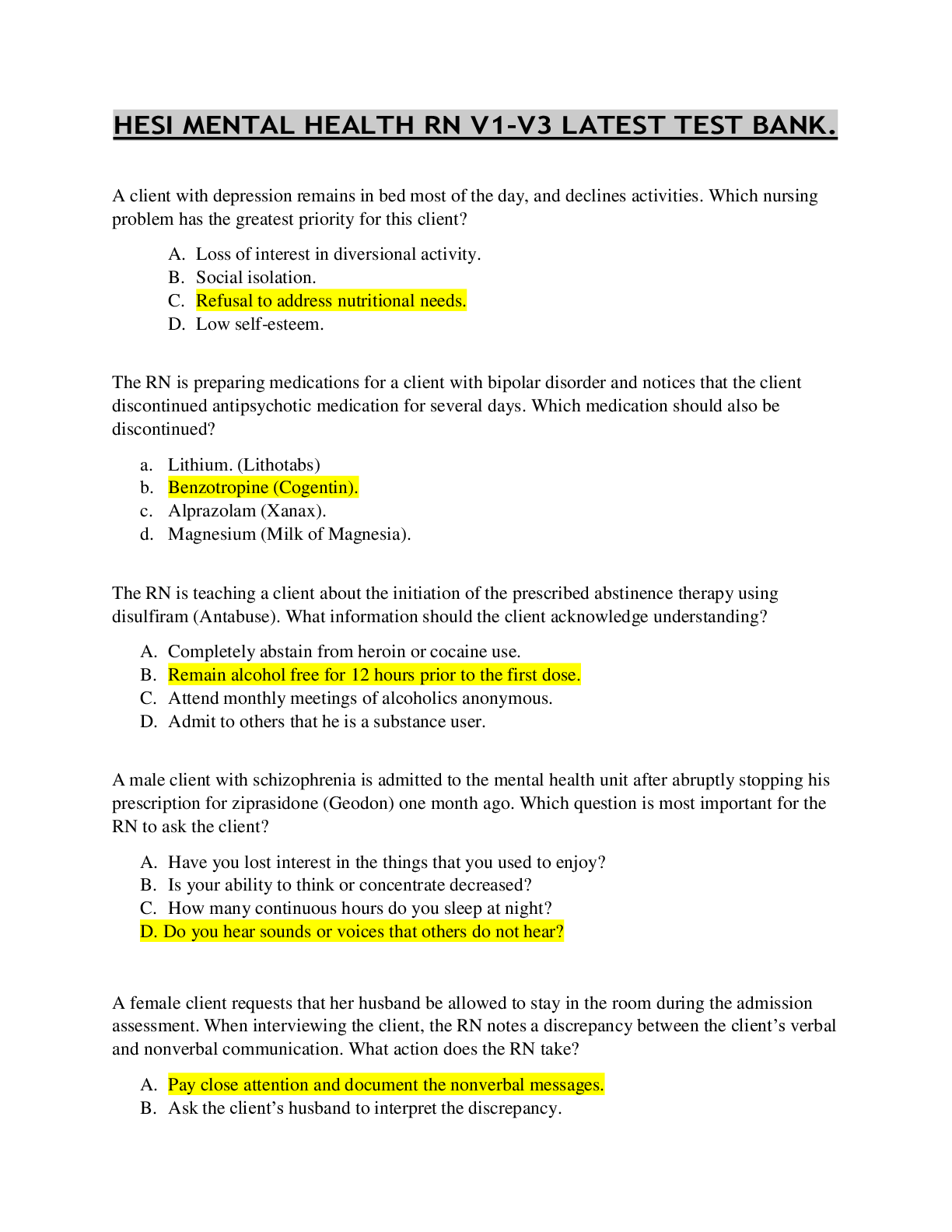
.png)
.png)



